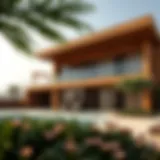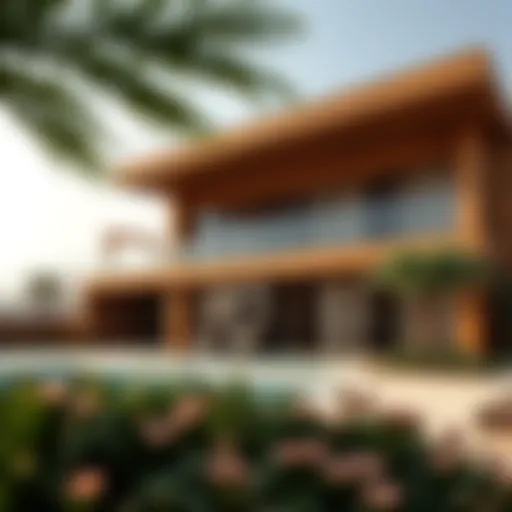Discover the Rooftop Café Experience in Dubai
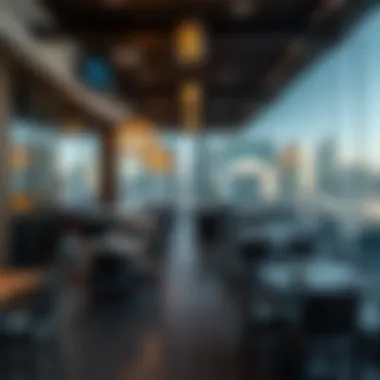

Intro
Dubai's skyline is a canvas of architectural marvels, but in this metropolitan hub, the true gems often lie a bit higher up. Rooftop cafés have blossomed into significant social spaces, offering more than just a cup of coffee; they serve up breathtaking views and an ambiance steeped in local culture. For investors, home buyers, and property managers, understanding this unique niche is crucial. This article explores the nuances of rooftop cafés, shedding light on their impact on Dubai's vibrant social scene.
With its ever-changing landscape, Dubai has seen an exponential increase in the popularity of rooftop venues. Whether it be a cozy nook overlooking the shimmering sea or a lavish terrace capturing the city lights, each rooftop café caters to various tastes and budgets. Investors looking for opportunities in the hospitality sector would do well to familiarize themselves with the prevailing market trends, as these spaces continue to redefine social interactions in a city that thrives on luxury living and modernity.
The following sections will delve into current market dynamics, predictions for the future, as well as insights into the types of properties that feature these elevated experiences.
Preface to Rooftop Cafés in Dubai
Rooftop cafés in Dubai offer more than just a place to sip your favorite coffee; they create a distinctive experience that enchants locals and tourists alike. These venues present a unique vantage point, marrying stunning views of Dubai’s skyline with an intimate atmosphere that sets them apart from traditional dining options. With the city's rapid development and vibrant social scene, the rise of these cafés reflects broader trends in hospitality and lifestyle, encapsulating a blend of history and modernity.
Historical Context
To truly understand the allure of rooftop cafés in Dubai, we must first consider the historical backdrop. Dubai's transformation from a modest fishing village into a global metropolis is nothing short of remarkable. The late 20th century saw an influx of expatriates, resulting in a dynamic cultural environment. With this change, the demand for innovative dining experiences grew. Rooftop cafés began to emerge as a response to this trend, providing not just meals but also a setting for social gatherings that heighten the communal experience. They stand atop towering structures, symbolizing Dubai’s relentless ambition and showcasing the skyline that has become iconic.
"The rise of rooftop cafés encapsulates the essence of Dubai's growth—an elevation, both literally and figuratively, of the social dining experience."
Looking back, early establishments might have offered simple fare and drinks, but they laid the groundwork for the diverse menu offerings we see today. Evolution in architectural styles also played a role—many rooftops began adopting an open-air concept to enhance the connection between diners and the vibrant atmosphere surrounding them.
The Evolution of Hospitality
Hospitality in Dubai, much like the city itself, has evolved rapidly. The introduction of rooftop cafés marks a significant chapter in this evolution. Initially, dining options were largely confined to hotel lounges or ground-level eateries. But as the city grew, so did the desire for something innovative—dining that allows patrons to escape the hustle and bustle while still soaking in the city’s vibrant energy.
Rooftop cafés provided a new canvas for culinary creativity. Chefs began crafting menus that not only reflect local flavors but also introduce an international flair, resulting in a fusion of tastes that caters to the diverse population of Dubai. Today, these cafés are seen as urban oases, where guests can connect, unwind, and indulge in culinary delights, all while surveying the breathtaking landscape around them.
In summary, the introduction of rooftop cafés in Dubai illustrates the interplay between social dynamics and culinary innovation, offering a glimpse into how the past shapes present and future trends in the restaurant industry.
Architectural Styles of Rooftop Cafés
When discussing the rooftop café scene in Dubai, architectural styles play a pivotal role in not only attracting patrons but also creating a unique identity for each venue. The diversity in designs often reflects the cultural melting pot that Dubai is known for. Rooftop cafés are more than just places to sip coffee; they are experiences sculpted in concrete and glass, where design and function intertwine beautifully. Each architectural style carries with it a narrative of the café’s ethos, catering to various tastes and expectations. In this context, understanding these styles becomes essential for investors, property managers, and anyone looking to engage with Dubai's vibrant hospitality industry.
Modern Designs
Modern designs in rooftop cafés often prioritize minimalism and functionality. You’ll find expansive glass panels that allow natural light to flood in, creating an open and airy feeling. These cafés embrace sleek lines and contemporary furnishings, often featuring innovative materials that reflect the latest architectural trends.
Some characteristics of modern rooftop cafés include:
- Panoramic Views: Large windows and open terraces provide breathtaking views of the Dubai skyline, making them excellent spots for sunset catchers.
- Integration with Nature: Many modern cafés incorporate greenery, blurring the lines between architecture and landscape. Living walls and planters can create relaxing spaces even in bustling urban settings.
- Technology: The integration of smart technology, such as automated shading and climate control systems, enhances guest comfort without compromising on aesthetics.
These designs not only elevate the customer experience but can also lead to increased foot traffic, which is beneficial for business.
Traditional Influences
On the flip side, traditional influences in rooftop café architecture pay homage to the rich history and culture of the region. These cafés often feature intricate designs, such as ornate patterns, warm colors, and traditional materials like wood and stone. They create an ambiance reminiscent of the past while still providing modern comforts.
Incorporating traditional elements can result in:
- Cultural Experiences: Cafés that embrace traditional architecture often provide cultural performances or local art, inviting patrons to immerse themselves in local heritage.
- Community Spaces: These cafés serve as community hubs where people gather, making them valuable in terms of social dynamics.
- Unique Designs: Each traditional café may feature unique characteristics inspired by various local architectural styles, contributing to a diverse rooftop café landscape in the city.
This blending of past and present can enhance the allure for both tourists and locals alike.
Sustainable Architecture
Sustainable architecture is gaining traction among rooftop cafés in Dubai as more venues recognize their footprint on the environment. This approach considers how materials, designs, and technologies impact sustainability while enhancing customer experience.
Key features of sustainable rooftop cafés often include:
- Recycled Materials: Using repurposed or eco-friendly materials not only lowers environmental impact but can also appeal to conscious consumers.
- Energy Efficiency: Many cafés are now designed with energy-efficient appliances, solar panels, and natural ventilation, which are increasingly important given Dubai's climate.
- Water Conservation: Innovations like greywater systems for irrigation help maintain greenery while conserving vital resources.
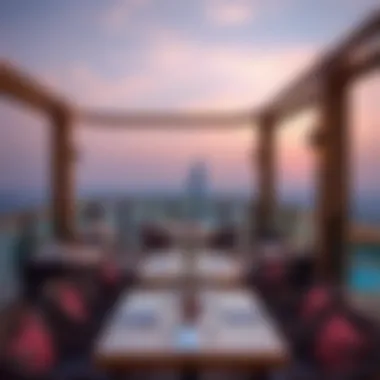

By adopting sustainable practices, rooftop cafés can establish themselves as responsible entities in the wider context of Dubai’s thriving hospitality industry. The careful balance of design elements, whether modern, traditional, or sustainable, shapes the overall café experience and enhances the appeal to diverse clientele.
"The architectural style of a rooftop café is often its first impression, setting the stage for what patrons can expect."
Ultimately, the architectural diversity among rooftop cafés in Dubai caters to a wide audience, offering everything from trendy spots for the modern urban dweller to charming hideaways that echo the city's rich history. This dynamic landscape not only enhances the café experience but also serves as a testament to Dubai's evolving urban narrative.
Cultural Significance of Rooftop Cafés
Rooftop cafés in Dubai symbolize much more than just a spot to grab a bite and sip coffee. They represent a cultural melting pot, reflecting the city’s dynamic essence by marrying culinary creativity with social interactions. This intersection of culture and community is noteworthy. In a city known for its rapid development and ever-changing skyline, these venues offer a something different – spaces where tradition meets modernity, and locals and visitors alike can gather under the open sky.
The rooftop café experience fosters relationships and nurtures connections among patrons. Friends meet up to unwind after work, families gather to celebrate milestones, and couples find romantic escapes from the hustle of daily life. Often filled with laughter and conversation, these cafés transmute simple leisure time into vibrant social events that forge meaningful interactions.
Another layer to the cultural significance lies in how these spaces ignite dialogues about heritage and identity. Rooftop cafés sometimes incorporate local traditions in their designs or menus, showcasing Emirati influences alongside international flavors. This culinary and aesthetic fusion allows for a rich tapestry of experiences. The cafés embody an essence of inclusivity, as diners sample dishes ranging from traditional Emirati fare to global offerings, creating a unique culinary landscape that reflects the city’s diverse population.
Social Dynamics
In the bustling cities, rooftop cafés become hubs of activity, often buzzing with vibrant energy. The essence of social dynamics leaps forth here, as these spaces thrive on interaction. Many rooftop venues in Dubai have spacious seating arrangements that encourage dialogue. A patron might engage in conversation with a longtime friend at one table while sharing a laugh with new acquaintances at another. This feeling of community fosters a sense of belonging, which is essential in such a fast-paced environment.
- Inclusiveness: The interaction among diverse groups is an intrinsic aspect of social dynamics at these cafés.
- Networking: Many professionals use these venues for informal meetings and networking, allowing for synergies that might not happen in more formal settings.
- Cultural Exchange: Visitors from around the world share their stories, experiences, and traditions, enriching the cultural dialogue that takes place in these settings.
Culinary Fusion
The culinary offerings at rooftop cafés in Dubai are where the magic truly happens. Chefs often embrace innovation, blending flavors from various cultures. This culinary fusion becomes a conversation starter amongst patrons, as unique dishes often spark intrigue and appreciation. Diners can find local specialties infused with international ingredients or cooking techniques.
For instance, a café might serve Shawarma-topped pizzas, combining traditional Middle Eastern flavors with an Italian classic. This interplay of flavors allows for unforgettable dining experiences that celebrate the city’s multicultural identity.
- Signature Dishes: Each café usually fiests its own spin on popular dishes, making it a delightful journey for food lovers.
- Seasonal Menus: Some establishments offer menu changes based on local seasonal ingredients, promoting sustainability while keeping the culinary experience fresh and exciting.
- Diverse Drink Offerings: The drink menus are often equally diverse, featuring everything from refreshing Arabic mint lemonade to international wines that complement the culinary experience.
"Rooftop cafés transcend mere food and drink; they become living entities reflecting the ethos of Dubai’s social and cultural landscape."
Popular Rooftop Cafés in Dubai
Rooftop cafés in Dubai are not merely dining spots; they are immersive experiences that elevate how we view both the skyline and the local culture. These venues encapsulate the essence of what it means to enjoy life against a backdrop of breathtaking views and vibrant conversations. By highlighting popular rooftop cafés, we recognize their role in shaping social dynamics, culinary innovation, and economic contributions. Each café serves as a microcosm of Dubai’s diverse tapestry, where tradition meets modernity, and locals intermingle with visitors, sharing stories over shared meals.
Overview of Top Spots
Dubai boasts a myriad of rooftop cafes that cater to every taste—be it opulence, modern chic, or cozy intimacy. Some notable spots include:
- Atmosphere at Burj Khalifa: This café is on the 122nd floor, offering unparalleled views of the city.
- Zeta Seventy Seven: With its stunning views of the Palm Jumeirah, it is ideal for a sunset dinner.
- TOMO: Known for its rubbery air and traditional Japanese fare, it offers both culture and cuisine.
- Cé La Vi: Located atop the Address Sky View hotel, famous for its partying scene and modern Asian menu.
Each of these cafes offers a different slice of Dubai’s nightlife and culinary art, making them integral to both the local landscape and the tourism sector.
Unique Offerings at Each Venue
What sets these spots apart is their unique blend of atmosphere, culinary options, and creative concepts. For instance:
- Atmosphere prides itself on an elegant dining experience with an exquisite menu crafted by renowned chefs. Guests can relish a seven-course tasting menu while gazing down at the bustling city below.
- Zeta Seventy Seven serves up a diverse menu that features a fusion of Asian and Western dishes, appealing to a broad audience looking for both flavor and ambiance.
- TOMO not only brings traditional Japanese cuisine to the mix but also incorporates seasonal ingredients, ensuring a fresh palate with every visit.
- Cé La Vi is noteworthy for its cocktail selections and live music, creating a buzz that attracts a younger crowd.
This unique character of each venue fosters a sense of discovery and adventure for diners seeking new tastes and experiences.
Comparison of Ambiance and Vibe
The ambiance at rooftop cafés can greatly influence a visitor's experience. The various settings range from romantic and serene to vibrant and lively. Here’s how they stack up:
- Atmosphere: Luxurious and serene, with soft music that encourages quiet conversations.
- Zeta Seventy Seven: Casual yet upscale, it creates a vibrant energy, especially during happy hours.
- TOMO: Reflects the tranquility of nature with its Japanese gardens and calm decor, appealing to those who seek peace in a bustling city.
- Cé La Vi: A hotspot for nightlife, it buzzes with energy, making it perfect for social gatherings and celebrations.
In summarizing the ambiance, we realize that each venue caters to distinct tastes and experiences, solidifying their unique position in Dubai’s dining landscape. Readers can rely on this knowledge when deciding where to unwind after a long day or to celebrate special occasions with loved ones.
Whether it's the food, the view, or the energy, rooftop cafés offer a vivid experience that reflects the dynamic spirit of Dubai. As these venues flourish, they undoubtedly solidify the city's reputation as a leading global destination for cultural and culinary excellence.
Culinary Offerings at Rooftop Cafés
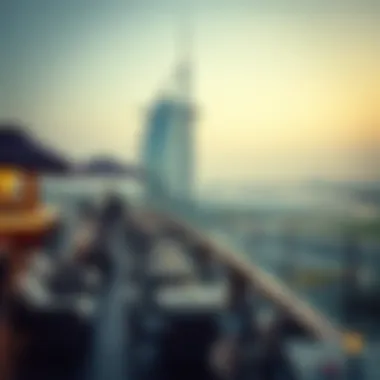

Culinary offerings at rooftop cafés in Dubai present a unique intersection of culture, flavor, and innovation. This aspect is crucial as it defines the overall experience that patrons engage in. Rooftop cafés not only serve food and beverages; they curate experiences that blend the visual delight of a stunning skyline with gastronomic innovations. By focusing on various offerings such as signature dishes and an elaborate beverage selection, these cafés play a significant role in shaping Dubai's dining landscape.
The culinary scene is not merely about sustenance; it’s about creating memorable moments. Patrons often seek an experience that tantalizes their taste buds while providing a striking backdrop. To this end, cafés often collaborate with renowned chefs and mixologists, ensuring that their menus boast an array of artistic and delicious choices. This harmony between food and environment is what sets rooftop cafés apart.
Signature Dishes
Rooftop cafés in Dubai are known for their standout dishes that often reflect the city's diverse cultural tapestry. Signature dishes are not just about local flair but also cleverly incorporate international cuisines, inviting guests to a culinary journey without leaving their seats.
- Emirati Shawarma: A local favorite, it is often prepared with slow-roasted meats accompanied by a tangy garlic sauce, bringing a taste of Emirati pride.
- Pan-Asian Fusion: From sushi-tacos to Thai basil chicken sliders, fusion dishes are a staple, reflecting Dubai's multicultural aspects. They resonate well with both locals and tourists.
- Vegan Options: Many cafes are adapting to dietary preferences by offering innovative plant-based dishes, such as raw beetroot tartare paired with cashew cream, which helps cater to health-conscious clientele.
The signature dishes, therefore, not only highlight culinary skill but also enhance the overall ethos of each café. They tell a story, often tied to the location's history, culture, or individual chef's journey.
Beverage Selection
In the realm of rooftop cafés, drinks can dramatically influence the ambiance, enhancing the dining experience. An exceptional beverage selection complements the culinary offerings, creating a holistic dining experience.
- Craft Cocktails: Many cafés focus on craft cocktails that utilize local ingredients, like saffron-infused gin or rosewater mojitos, which are refreshing while also offering a taste of the region.
- Artisan Coffee: With Dubai's increasing coffee culture, some cafés take pride in their artisan coffee selections. From specialty brews sourced from South America to local blends, the coffee experience here is thoroughly tailored to please aficionados and casual drinkers alike.
- Mocktails and Smoothies: For those opting for non-alcoholic beverages, creative mocktail options are on hand, like the ginger-lime fizz, offering vibrant flavors that make one forget they’re alcohol-free.
The diversity of beverages available at these cafés elevates the experience. Patrons can enjoy a drink that perfectly pairs with their meal or simply sip something refreshing while gazing at the skyline.
The Experience: More Than Just a Meal
Rooftop cafés in Dubai are not merely places to grab a bite or sip a drink; they represent a unique intersection of culture, luxury, and leisure. The ambience and experience offered by these venues go beyond food. They create a seamless blend of social interactions and remarkable vistas, deeply influencing Dubai's vibrant dining scene. By looking at the various elements that shape the experience at these cafés, one can appreciate why they are an integral part of the city's lifestyle.
Atmosphere and Setting
The atmosphere in rooftop cafés tends to be curated to provide guests with more than just a meal — it’s about creating memories. Each café adopts its own character, influenced by architecture, interior design, and location.
- Design Choices: From lush greenery sprawled across balconies to minimalist chic décor, the layout affects the mood. For example, a café with a Mediterranean flair may have whitewashed interiors and colorful accessories, reflecting a specific ethos while creating a calming vibe.
- Lighting and Soundscapes: Rooftop venues pay particular attention to lighting, using it to set the tone. Dimmed lights create intimacy, while bright settings may encourage energy and lively conversation. Sounds from nearby festivities often blend with the café's music, adding to the overall ambiance and making every visit unique.
- Social Space: The arrangement of seating plays a crucial role. Cozy corners invite intimate discussions, while long communal tables foster engagement among guests. Be it a romantic dinner, a casual meetup with friends, or a business lunch, the atmosphere adapts to fit the occasion.
The backdrop of a sprawling city skyline draws diners in, but it’s the thoughtful design and social interplay that keeps them coming back.
Views and Aesthetics
The views that accompany a meal at a rooftop café are often jaw-dropping and serve as a backdrop to the entire dining experience, making it unlike anything else.
- Skyline Perspectives: Overlooking Dubai's panoramic skyline or twinkling Arabian Gulf presents a picturesque scene that alters with the time of day. As dusk falls, the transformation of the city into a sea of lights is often memorable, setting the stage for a romantic meal or a festive night.
- Nature’s Touch: Many rooftop cafés beautifully incorporate nature. Think lush gardens and flowing water features that merge seamlessly with high-rise designs. The contrast between urban life and nature creates a sensory escape that is rare in a bustling city.
"A meal without an inspiring view is like a book without prose; the essence lies in the details that adorn it."
- Artistic Elements: Murals, sculptures, and decorative installations enhance the visual appeal of these cafés. These artistic choices often tell a story, inviting guests to engage with the surrounding space in a deeper way.
Overall, the views and aesthetics of rooftop cafés in Dubai transcend mere decoration — they elevate the experience to something memorable and monumental, attracting visitors and residents alike. The careful orchestration of atmosphere, setting, and breathtaking views contributes significantly to why rooftop dining has become an essential part of Dubai’s culinary and social heritage.
Impact on Local Economy
Rooftop cafés in Dubai play a pivotal role in shaping the city’s economic landscape. With its booming hospitality sector, these cafés are not merely places for relaxation but are also significant contributors to local economic vitality. The presence of these venues fosters various opportunities, encouraging investment, job creation, and enhancing the overall appeal of Dubai as a tourist destination.
Employment Opportunities
The rise of rooftop cafés translates directly into numerous job openings across various sectors. From baristas to managers, the employment spectrum is vast. A single café can employ a mix of full-time and part-time workers, catering to the diverse needs of residents and tourists alike. For example:
- Baristas and servers - skilled individuals provide excellent service to customers, ensuring a welcoming atmosphere.
- Culinary staff - chefs and kitchen staff are crucial in crafting signature dishes that draw patrons.
- Maintenance and management roles - are essential for operational efficiency and aesthetic upkeep of these scenic venues.
As more rooftops transform into vibrant spaces, they are likely to pull in talent not just locally but from abroad. This blend of local and international workforce can enhance cultural exchange, promoting a more inclusive workplace. Therefore, the impact on employment isn’t just about numbers; it enriches the environment within which these cafés operate, creating a melting pot of ideas and cultures.
Tourism Boost
Dubai is renowned for its tourist attractions, and rooftop cafés have become the icing on the cake for many visitors. Tourists are increasingly seeking memorable experiences, and the stunning views offered by rooftop cafés meet that demand. They become a go-to choice for many tourists looking to unwind after a day of exploration. This surge in demand can be broken down into several areas:
- Attraction for both leisure and events - couples hosting proposals or friends getting together for celebrations often choose these scenic spots.
- Promotion through social media - platforms like Instagram allow visitors to share their experiences, effectively acting as free marketing; picturesque images of the skyline with a beverage can entice more visitors.
- Economic ripple effects - increased foot traffic not only benefits the cafés directly but also local businesses, as tourists often explore nearby shops or other attractions after their café experience.


Ultimately, the clout of rooftop cafés goes beyond the immediate financial benefits, cultivating a richer narrative around Dubai’s tourism offerings. Their ability to merge breathtaking views with culinary delights creates an ecosystem that support both residents and tourists alike, invigorating the local economy while setting the stage for the city to enhance its global standing in the hospitality sector.
Challenges Facing Rooftop Cafés
In a city like Dubai, where every inch of space counts and competition is fierce, rooftop cafés face a myriad of challenges that can impact their sustainability and growth. The combination of regulatory frameworks and market dynamics plays a significant role in shaping the operational landscape of these venues. Understanding these hurdles provides insight into how to navigate the complexities of the rooftop café business in this vibrant metropolis.
Regulatory Hurdles
The regulatory environment in Dubai can be daunting for rooftop cafés. Different rules govern everything from building permits to health and safety standards. For instance, obtaining the necessary licenses can be a lengthy and complicated process, often requiring multiple approvals from various governmental bodies. This requires potential café owners to be well-acquainted with local laws and practices.
- Health Regulations: Rooftop cafés must adhere to strict health and safety guidelines, ensuring that food and beverage offerings meet the standards set by the Dubai Municipality.
- Licensing: A valid food service license is non-negotiable, and additional permits may be needed if a café plans to serve shisha or hold events.
- Building Codes: As they are situated on the rooftops, structural safety inspections are mandatory. This can lead to additional costs and delays in opening.
These regulations, while meant to ensure public safety and compliance, can ward off potential entrepreneurs, making them think twice before investing in this sector.
Market Competition
The lively atmosphere of Dubai’s hospitality market attracts numerous entrepreneurs eager to create the next desirable rooftop spot. However, rapid growth leads to intense competition. The abundance of options can overwhelm potential customers, forcing café owners to differentiate themselves effectively. Consider the following challenges:
- Brand Differentiation: With many cafés offering similar concepts or views, it becomes crucial for owners to find unique selling points. Establishing a distinctive identity that resonates with their target audience can require substantial time and marketing resources.
- Customer Loyalty: Consumer preferences are fickle, and in a city that thrives on trends, maintaining a loyal customer base can be likened to walking a tightrope. Rooftop cafés must continuously engage their patrons through themed events or unique culinary offerings to keep them coming back.
- Economic Factors: External economic factors, like the fluctuations in tourism, can impact foot traffic significantly. A sudden drop in tourist numbers may lead to decreased revenue, necessitating a quick pivot or adaptation in strategy.
Future Trends in Rooftop Cafés
As Dubai continues to evolve as a global hub for leisure and lifestyle, the rooftop café scene is also dynamically shifting. The popularity of these cafés is not merely a passing adornment for the skyline; instead, they symbolize a broader movement towards integrating technology, sustainability, and community engagement. Understanding these future trends can shed light on the direction that rooftop cafés are headed and the implications they have for investors, property managers, and patrons alike.
Technological Integration
In recent years, the integration of technology into dining experiences has skyrocketed. Rooftop cafés in Dubai are no exception. Many establishments are adopting innovative solutions to enhance customer experiences. Imagine ordering via a mobile app while enjoying the sunset over the Dubai skyline. Some places utilize augmented reality to provide menus that showcase the ingredients’ origins or even the preparation method. This not only enriches the dining experience but also fosters an emotional connection to the food served.
Moreover, smart systems are becoming prevalent. For instance, automated bookings and payment processing streamline the customer journey, making dining more efficient and less friction-filled. This technological pivot not only elevates customer satisfaction rates but also provides valuable data insights. These insights can help café owners tailor their offerings and campaigns, aligning more closely with customer preferences and behaviors.
"As technology continues to redefine dining, it forms an essential backbone for the future of rooftop cafés, combining luxury with convenience."
Benefits of Technological Integration
- Enhanced Customer Experience: Through interactive menus and seamless payment options, patrons can engage more with their dining experience.
- Operational Efficiency: Café owners can optimize their resources and understand consumer preferences better through collected data.
- Increased Engagement: Technologies such as social media integration can enhance brand presence and customer loyalty.
Evolving Customer Preferences
Examining the evolving tastes of patrons reveals another essential trend shaping the rooftop café landscape. Today’s customers are increasingly health-conscious and environmentally aware, leading many cafés to pivot towards organic menus and locally sourced ingredients. Rooftop cafés that emphasize sustainability tend to capture the attention of discerning diners who wish to align their choices with their values.
The drink offerings have also morphed. Rather than just regular coffee or cocktails, customers are leaning towards artisanal beverages with a story behind them, be it locally roasted coffee or craft cocktails made from organic fruits. This shift isn't just limited to food but is permeating the overall vibe of the café. Patrons prefer unique experiences over traditional dining, seeking out venues that offer specific aesthetics or themed events, such as sunset yoga sessions followed by smoothies.
Considerations for Rooftop Cafés
- Understanding Customer Values: Cafés must tune in to their customers’ emphasis on health and sustainability to stay relevant.
- Creating Memorable Experiences: A focus on unique offerings can distinguish one café from another in a saturated market.
- Community Engagement: Building a sense of community, perhaps through events or workshops, can foster loyalty and attract repeat customers.
In summary, as the rooftop café scene in Dubai continues to thrive, the integration of technology and evolving customer preferences will shape its future. These trends signify a shift towards a more conscious and engaged dining culture where experiences are not just about meals but about creating lasting memories and connections.
Ending
The growing trend of rooftop cafés in Dubai encapsulates more than just a dining experience; it represents a cultural phenomenon ingrained in the fabric of the city. Understanding the implications of this rooftop culture is crucial for various stakeholders, from investors to property managers, as it highlights potential in both the hospitality and real estate sectors.
First, the rooftop cafés signify a unique blend of architecture and social gathering, which offers both aesthetic appeal and functional versatility. The combination of impressive design with stunning views naturally attracts consumers, creating a compelling case for businesses looking to monetize these spaces. In addition, the construction of these cafés contributes to the skyline’s evolution, further establishing Dubai as a global destination for tourists and relocators alike.
Moreover, the atmosphere crafted by these venues often leads to increased customer loyalty. Many visitors cherish the opportunity to unwind in a lovely setting while enjoying diverse culinary offerings. This behavior not only fosters repeat business but also enhances word-of-mouth marketing in an age when social media plays a significant role in consumer choices. Rooftop cafés therefore become not just places to dine, but also vital touchpoints for community engagement.
However, it is not without challenges. As highlighted in previous sections, regulations and market competition can hinder growth for new entrants in the rooftop café scene. Understanding these factors and developing strategies to navigate through them is vital for sustained success.
In summary, the rooftop café experience enriches life in Dubai, contributing to its lively social dynamism and offering profitable opportunities in hospitality and real estate. Investors, renters, and property managers should be attuned to this trend, as it represents an avenue toward understanding consumer preferences and capitalizing on the city’s economic and cultural landscape.
Final Reflections on Rooftop Culture in Dubai
Rooftop culture in Dubai is emblematic of the larger shifts occurring within the city's hospitality landscape. As societal habits evolve, so do the venues where people choose to gather. Rooftop cafés epitomize a reflection of modern life—people seek not only sustenance but also a sense of community and connection to their environment.
From lavish venues like At.mosphere in the Burj Khalifa to more intimate spots such as The Penthouse at Five Palm Jumeirah, each rooftop café brings its own flair, perfectly blending culinary artistry with the breathtaking panoramas of the city. This diversity caters to varying tastes and budgets, ensuring that all visitors can find a place to enjoy.
The significance of rooftop cafés extends beyond mere consumption. They allow locals and tourists alike to pause, reflect, and appreciate the rich tapestry of cultures that converge in Dubai. Here, you can sip a cup of Arabic coffee while gazing at the shimmering skyline or enjoy an eclectic meal with a backdrop of the calm sea. This is where culinary tradition meets modern innovation—an intersection eagerly explored by those who understand Dubai's rhythm.


